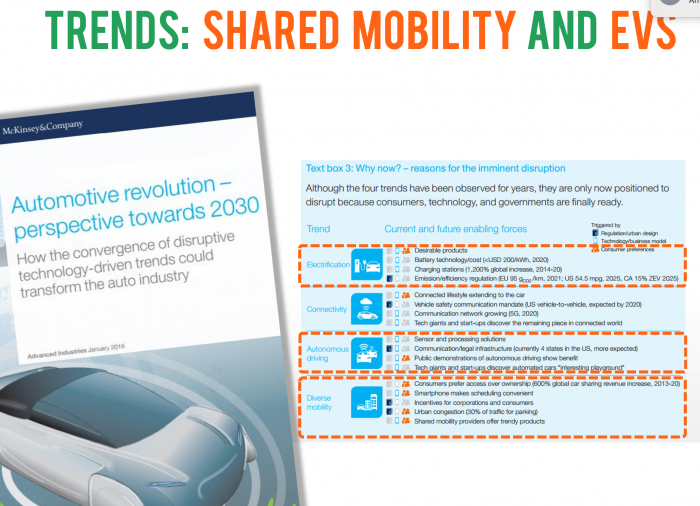Where Sustainable Mobility Is Heading the 2020s
In 2020, many corporations will be prioritizing sustainability thanks to increased awareness in the consumer market, developments in green tech, and pressure from government policies to curb greenhouse gas emissions.
In particular, emerging technologies have opened up new ways of devising viable solutions for the electrification of transportation. Here are some recent developments that point to the convergence of influences and upcoming trends in green mobility:
EUROPEAN COUNTRIES GETTING INTO THE BATTERY GAME
Battery manufacturing has been dominated by Asian firms but it’s about to change as Germany and France plan to invest 1.75 billion euros to accelerate battery cell production.
The strategy is designed to “ensure global leadership for Europe in both electric vehicle technology and autonomous driving” — meaning that governments of these countries are realizing that EVs and autonomous driving will be dominant components in the future of transportation.
DAIMLER AND BMW INVESTING IN RIDE-HAILING
Car manufacturers are realizing that the future of transportation no longer lies in ownership. Instead, the rise of the sharing economy and the imminent wide adoption of autonomous vehicles means adding ride-hailing (or TaaS — Transportation as a Service) to their business models is key to remaining relevant and profitable.
German carmakers Daimler and BMW recently announced that they’re investing 1 billion euros in a ride-hailing venture to compete with Uber. Meanwhile, consultancy PwC indicated that carmakers will face marginalization by cash-rich technology firms unless they develop services based on vehicle usage.
USPS ADOPTING ELECTRIC STEP VANS
Motiv Power Systems is building seven fully electric mid-sized delivery vans for the United States Postal Service as part of a California Air Resources Board-funded program. Compared to the existing gasoline and diesel delivery vehicles, these trucks are cleaner, quieter, cheaper to fuel, and less costly to maintain.
Similarly, and in a commercial context, Tanktwo has been working with DHL to develop a fleet of electric vans that will make the electrification of commercial delivery fleets viable using its patented technologies.
ESTABLISHED OIL COMPANIES INVESTING IN EV TECHNOLOGIES
BP Ventures is investing in Chinese start-up PowerShare, which links electric vehicle drivers to charging points and helps power suppliers balance distribution. This is one of the many investments made by big oil companies in green tech to stay relevant in future low-carbon economies.
This also reflects one of the concerns that utility companies have about power demand from the growing number of EVs. These vehicles will draw a significant amount of energy from the grid and a large portion of today’s infrastructure won’t be able to support the fast-charging stations proposed by many manufacturers.
BETTER UNDERSTANDING OF POWER LOSSES IN EVS
To optimize the efficiency of EVs, it’s important to minimize the loss of energy in the various components (e.g., EV drivetrain.) A study on semiconductor losses revealed that smaller switches distributed over time, place, and fluctuating needs will result in more efficient use of resources.
The ability to minimize energy loss in batteries is made possible by the use of optimization algorithms that create highly efficient systems. For example, Tanktwo’s patented technologies create an ecosystem consisting of smart String Cells (which are smaller and more adaptable than large “monolithic” batteries used in current EVs) and routing optimization algorithms to maximize the efficiency of the battery pack.
THE CONVERGENCE OF INFLUENCES: SUSTAINABLE MOBILITY TRENDS
These recent events point to the convergence of influences in the transportation industry. Here are a few insights on where we’re heading:
Mobility solutions are going green and businesses will be seeking EV battery and charging solutions that are commercially viable. They need to minimize the time EVs take to refuel and devise refueling solutions that are compatible with existing operational procedures and infrastructure to reduce upfront costs.
TaaS, ride-hailing, and shared mobility will continue to grow. While this is one of the keys to reducing greenhouse gas emissions and optimizing resource usage, we need a different system of powering and refueling EVs in order to turn business plans into reality.
As we have more EVs on the road, existing power grids will be taxed. Also, infrastructure in many locations simply isn’t built for the load required by EV charging stations. We need a battery technology that also acts as an energy storage solution so electric power can be stored and distributed to where it’s needed independent of the grid’s capacity.
The use of data analytics and asset optimization algorithms will create opportunities to minimize wastage by using smaller battery units (as opposed to inflexible “monolithic” blocks) and increase profits through dynamic allocation.
Developments in sustainable mobility in the coming decade will focus on creating more efficiencies by synergistically combining proven technologies from various sectors to devise solutions that will make electrification on a commercial scale viable and profitable.
The opportunities are right under our noses. The key to profiting from this convergence of influence is to position yourself in the right place and at the right time to “flip the switch” when the time comes — which is any minute now.


